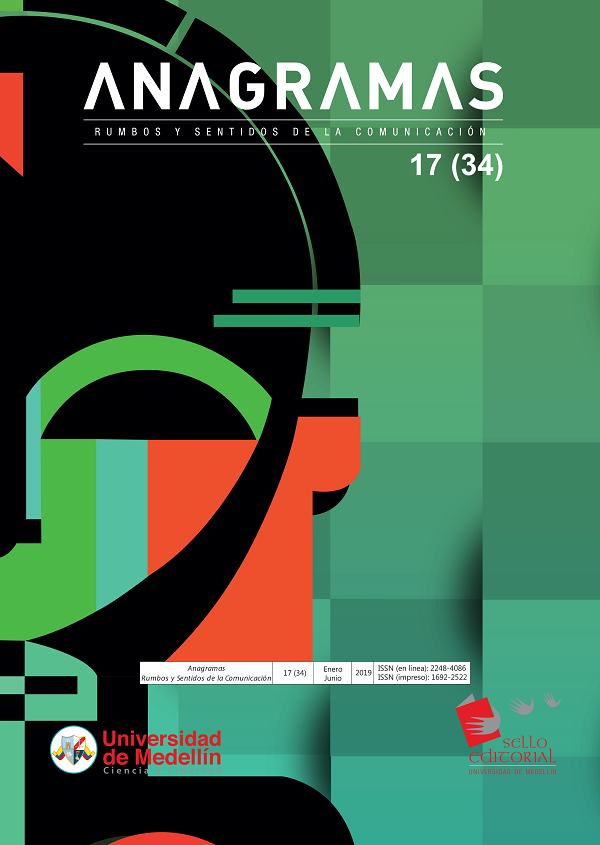Asociaciones olfativas en torno a la percepción del espacio y el servicio recibido por los asociados a un fondo de empleados en Manizales
Derechos de autor 2023 Anagramas Rumbos y Sentidos de la Comunicación

Esta obra está bajo licencia internacional Creative Commons Reconocimiento-NoComercial-SinObrasDerivadas 4.0.
- Articles
- Enviado: julio 24, 2018
-
Publicado: junio 14, 2019
Resumen
El presente artículo muestra los resultados obtenidos en la investigación sobre marketing sensorial y su influencia en la experiencia de compra, el cual busca aportar conocimiento al campo del marketing sensorial y su importancia en la construcción de experiencias memorables para los públicos. De esta forma se quiere comprender si un aroma puede relacionarse con la experiencia del servicio recibido en las instalaciones de un fondo de empleados de Manizales por medio de una investigación cuantitativa-descriptiva de alcance correlacional cuasiexperimental.
En la primer semana se indagó en la percepción a 301 personas que ingresaron a las instalaciones del fondo de empleados sin intervención de algún esquema de aroma. Para la segunda semana se hizo una intervención, se recolectaron 301 encuestas a las personas que ingresaron y que calificaron las mismas variables en el espacio ya aromatizado.
Se sistematizaron los cuestionarios en una matriz en Microsoft Excel 2013® para, posteriormente, realizar el análisis estadístico con el IBM SPSS v. 21. Se verificó la consistencia interna con alfa de Cronbach de 0,856, se caracterizó la población y se establecieron asociaciones ordinales mediante el coeficiente Gamma de Goodman y Kruskal, adicionalmente se comprobaron con la prueba Chi-cuadrado las posibles asociaciones. Uno de los resultados más importantes del estudio demostró que la estimulación del sentido del olfato puede asociarse de manera positiva en la percepción de las variables de atención en el servicio y limpieza.
Referencias
Alcántara, E., Artacho, M., Zamora, T. y Martínez, N. (2014). Exploratory Study of the Influence of the Sensory Channel in Perception of Environments. Journal of Sensory Studies, 29(4), 258-271. doi:10.1111/joss.12099
Alfaro, E. (2012). El ABC del shopping experience. Cómo generar experiencias para vender más. Madrid: Wolters Kluwer.
Bouzas, D. G., Barrie, C. A., & Serra, T. (2011). Marketing olfatorio: el olor de los deseos. Harvard Deusto Marketing y Ventas, (103), 34-39.
Bonadeo, M. (2005). Odotipo: historia natural del olfato y su función en la identidad de marca (Tesis doctoral). Universidad Austral, Buenos Aires, Argentina.
Canniford, R., Riach, K. y Hill, T. (2017). Nosenography: How smell constitutes meaning, identity and temporal experience in spatial assemblages. Sage Journals, 18(2), 234-248. doi: 10.1177/1470593117732462
Chebat, C. y Michon, R. (2003). Impact of ambient odors on mall shoppers’ emotions, cognition, and spending: A test of competitive causal theories. Journal of Business Research, 56(7), 529-539. doi:10.1016/S01482963(01)00247-8
Derval, D. (2010). The Right Sensory Mix. Berlín: Springer-Verlag.
Fiore, A., Yah, X. y Yoh, E. (2000). Effects of a product display and environmental fragrancing on approach responses and pleasurable experiences. Psychology y Marketing, 17(1), 27-54. doi.org/10.1002/(SICI)1520-6793(200001)17:1<27::AID-MAR3>3.0.CO;2-C
Goldkuhl, L. y Styvén, M. (2007). Sensing the scent of service success. European Journal of Marketing, 41(11-12), 1297-1305. doi:10.1108/ 03090560710821189
Haase, J., Wiedmann, K. y Bettels, J. (2018). Sensory imagery in advertising: How the senses affect perceived product design and consumer attitude. Journal of Marketing Communications, 15(1), 2-3. doi:10.1080/13527266.2018.1518257
Hirsch, A. (1995). Effects of ambient odors on slot-machine usage in a Las Vegas Casino. Psychology and Marketing, 12, 585-594. doi: 10.1002/ mar.4220120703
Hulten, B. (2015). Marketing sensorial: el concepto de experiencia de marca multisensorial. European Business Review, 23(3), 256-273. doi.org/10.1108/09555341111130245
Ianinni, M. (2010). Marketing Olfativo un valor diferencial. MK: Marketing + ventas, 253(2010), 58-64.
Kivioja, K. (2017). Impact of point-of-purchase olfactory cues on purchase behavior. Journal of Consumer Marketing, 34(2), 119-131. doi:10.1108/JCM-08-2015-1506
Krishna, A. (2012). An integrative review of sensory marketing: Engaging the senses to affect perception, judgment and behavior. Journal of Consumer Psychology, 22, 33-351. doi: 10.1016/j.jcps.2011.08.003
Krishna A., Cian, L. y Aydınoğlu, N. (2017). Sensory Aspects of Package Design. Journal of Retailing, 93(1), 43-54. doi.org/10.1016/j.jretai.2016.12.002
Labenz, F., Wiedmann, K. P., Bettels, J., & Haase, J. (2018). Sensory Stimuli in Print Advertisement Analyzing the Effects on Selected Performance Indicators. Journal of International Business Research and Marketing, 3(2), 7-15.
Lehrner, J., Marwinski, G., Lehr, S., Johren, P. y Deecke, L. (2005). Ambient odors of orange and lavender reduce anxiety and improve mood in a dental office. Physiology and Behavior, 86(1-2), 92-95. doi: 10.1016/j.physbeh.2005.06.031
Lindstrom, M. (2009). Compradicción. Verdades y mentiras de por qué las personas compran. Bogotá: Norma, 248p.
Liljenquist, K., Zhong, C. y Galinsky, A. (2010). The smell of virtue. Clean scents promote reciprocity and charity. Psychological Science, 21, 381-383. doi:10.1177/0956797610361426
Manzano, R., Gavilán, D. Avello, M., Abril, C. y Serra, T. (2011). Marketing sensorial: comunicar con los sentidos en el punto de venta. Madrid: Prentice Hall.
Palomares, R. (2013). Marketing en el punto de venta: comunicación y promoción. Madrid: ESIC.
Piqueras-Fiszman, B. y Spence C. (2012). The Influence of the Feel of Product Packaging on the Perception of the Oral-somatosensory Texture of Food. Journal of Food Quality and Preference, 26(1), 67–73. doi:10.1016/j.foodqual.2012.04.002
Rimkute, J., Moraes, C. y Ferreira, C. (2016). The effects of scent on consumer behaviour. International Journal of Consumer Studies, 40(1), 24-34. doi:10.1111/ijcs.12206
Rupini, R.V. y Nandagopal, R. (2015). A Study on the Influence of Senses and the Effectiveness of Sensory Branding. Journal of Psychiatry, 18(2) 236. doi:10.4172/Psychiatry.1000236
Sánchez, J. y Pintado, T. (2012). Nuevas tendencias en comunicación. Madrid: ESIC.
Schifferstein, H. y Blok, S. (2002). The signal function of thematically (in) congruent ambient scents in a retail environment. Chemical Senses, 27(6), 539-549. Doi:10.1093/chemse/27.6.539
Schmitt, B. (2007) Experiential Marketing. Barcelona: Deusto.
Spence, C., Puccinelli N., Grewal D. y Roggeveen, A. (2014). Store Atmospherics: A Multisensory Perspective. Journal of Psychology and Marketing, 31(7), 472-488. doi: 10.1002/mar.20709





























